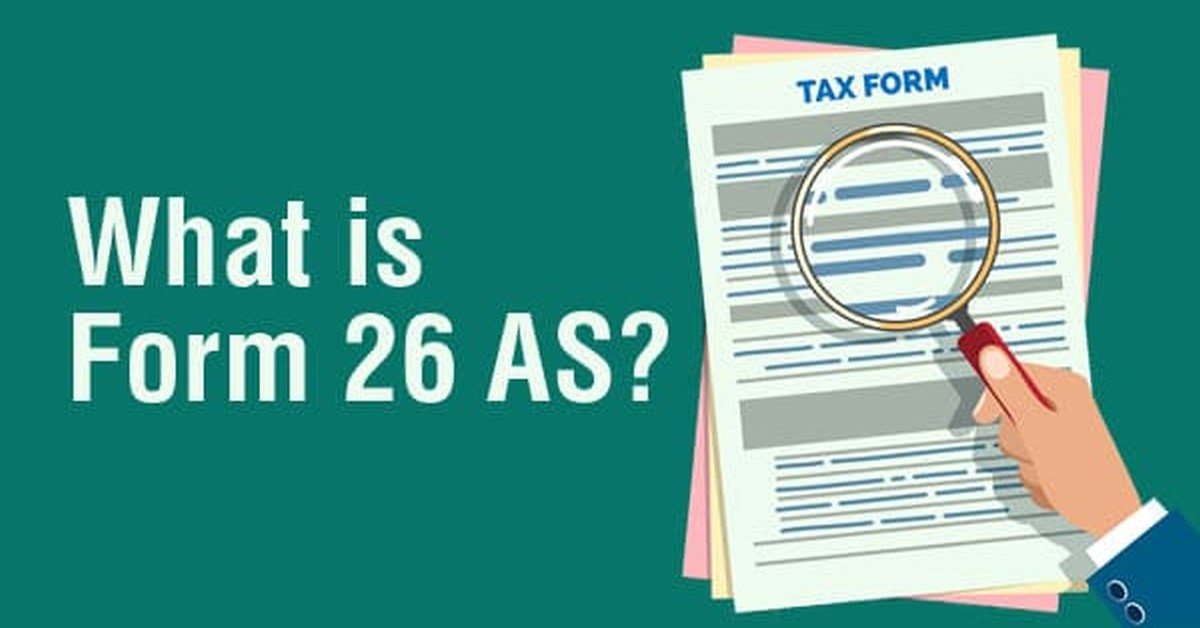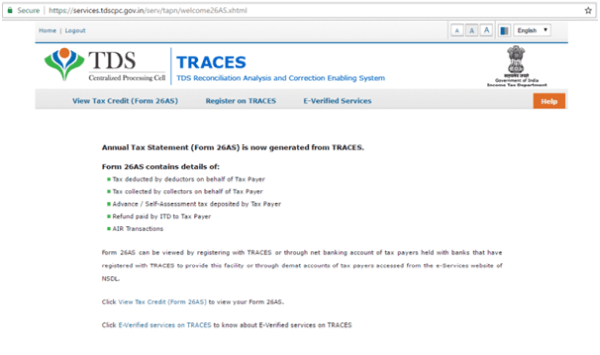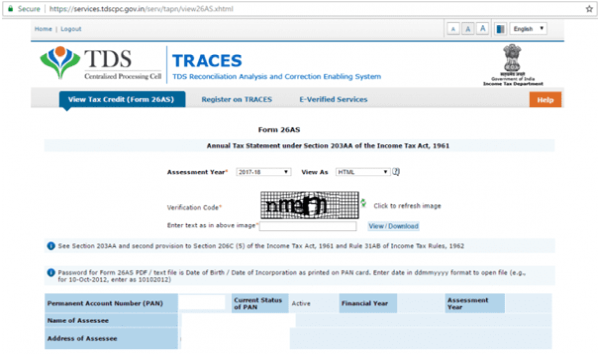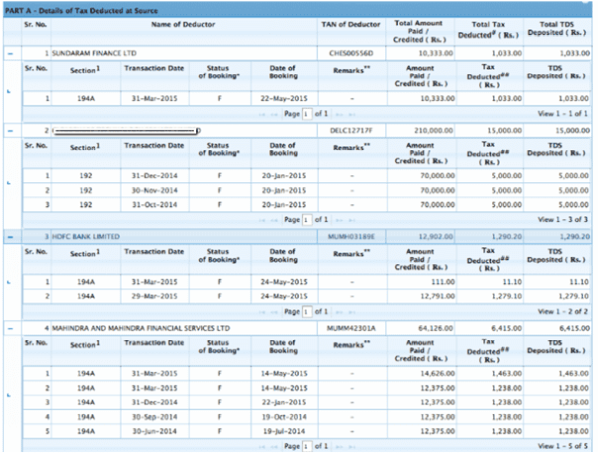HOW TO DOWNLOAD FORM 26AS FROM TRACES PORTAL?
What is Form 26AS?
To collect tax from the assessee in the previous year itself the government collects it in the form of TDS, TCS, and advance tax. However, the government also allows the assessee to claim the credit of such taxes while filing his Income Tax Return(ITR). To record, such tax credits of an assess the Department of Income Tax maintains Form 26AS. It is an annual consolidated tax statement that contains all the information related to the tax paid by an assessee, together with the income on which such tax has been deducted and the taxes which have been paid on behalf of the assessee by the deductor. It can be accessed by a taxpayer’s Permanent Account Number (PAN) and is one of the most important forms to verify the post-tax payment. In addition to this, the form also contains details of all your deductors like an employer, bank, etc. along with their Tax Deduction Account Number (TAN).
A taxpayer should note that while filing his Income Tax Return(ITR) the assessee can claim the credit of only that amount which is reflected in Form 26AS. For instance, If the actual TDS deducted as reflected in the TDS Statement differs from the TDS reflected in Form 26 AS. The taxpayer will not be eligible to claim the amount of actual TDS. Therefore it is very important that an assessee should view his Form 26AS before filing Income Tax Return(ITR) and make sure if the amount reflected in Form matches with the actual amount of TDS, TCS, or Advance Tax paid. It can be viewed and downloaded on the TRACES website or through the Net Banking Facility of Authorised Banks.

|
1 |
|
|
2 |
|
|
3. |
|
|
4. |
|
|
5 |
What is TRACES Portal?
TDS Reconciliation Analysis and Correction Enabling System or TRACES is an online portal of the Income Tax Department of India which helps bring all the stakeholders involved in the Tax Deducted at Source and Tax Collected at Source process together. The website is primarily used for downloading tax documents like Form 16, Form 16A, Form 26AS, which are essential for the deductor and taxpayer.
What does Form 26AS contain?
1. Information regarding tax deducted by the taxpayer’s deductor
2. Advance tax paid by the taxpayer
3. Self-assessment tax payments made
4. Refund received by the taxpayer during the Assessment Year
5. Information regarding tax collected by collectors
6. Details of all High-value Transactions with respect to shares, mutual fund etc. during the Financial Year
7. Regular assessment tax deposited by the taxpayers (PAN holders)
How to view and download from TRACES Portal?
Step 1: Go to e-filling website and click on "Login. If you are new to e-filing, then "Register' first.
Step 2: Enter user ID (PAN or Aadhaar) and password, then continue.
Step 3: Go to ‘e-file’.
Step 4: Select ‘Income Tax Returns’, then ‘View Form 26AS’ from the drop-down.
Step 5: Click ‘Confirm’ to the disclaimer to be redirected to the TRACES website.
Step 6: Read the contents and then click "Proceed' in the dialog box that appears.

Step 7: On the bottom of the page, click "View Tax Credit (Form 26AS)' to view your Form 26AS. You can also know about E-verified services on TRACES by clicking "E-Verified services on TRACES'.

Step 8: Enter the Assessment Year for which you want to view or download along with the Verification Code. Herein, you can download the form by changing the "View As' to PDF and then clicking on "Download'. If you want to view the form online, then keep the "View As' as HTML.

Step 9: Post entering all the details your Form 26AS will be downloaded or visible to you, as the case may be. You will also be required to enter a password which is your Date of Birth in the format DD/MM/YYYY.
What are the parts of Form 26AS?
Part A: Details of Tax Deducted at Source
Part A contains the details of TDS deducted on different income sources of a taxpayer, like his salary, pension, interest etc. In addition to that, the form also gives details of Tax Deduction Account Numbers (TAN) of different deductors along with the amount of TDS deducted or deposited. These details are provided to a taxpayer on quarterly basis.

1. Details of Tax Deducted at Source for Form 15G or 15H
Form 15G or 15H is to be submitted if you meet certain requirements after which, TDS is not deductible on your income. Form 15H is for senior citizens (whose age is more than 60 years), while Form 15G is for everyone else. If you have submitted any of these forms, you can verify them under this section, else this section will display "No transactions present'.

2. Details of Tax Deducted at Source on sale of Immovable Property u/s 194IA – For seller of property
As per Section 194IA of the Income Tax Act, 1961 a buyer of immovable property is supposed to deduct tax and deposit the same before making a payment to the seller on such property. If you have sold any immovable property in the Financial Year, then the details of TDS deducted on such income will be shown under this section and you can verify the same here.

Part B: Details of Tax Collected at Source
If you are a seller who collects tax at source, then the entries of such transactions will be visible under this part.

Part C: Details of Tax Paid (Other than TDS or TCS)
Following details are visible under this part:
1. Tax deposited by you
2. Advance tax paid
3. Self-assessment tax paid
4. Challan through which tax was deposited

Part D: Details of Paid Refund
This part contains details of refund of tax received for the Assessment Year. It also contains the mode of payment, amount of refund, interest, date of payment and remarks, if any.

Part E: Details of AIR transactions
Annual Information Return is a summary of all the "high value transactions' made by a taxpayer in the Assessment Year. These transactions are reported to the tax authorities by banks and other financial institutions. Some of these "high value transactions' include mutual funds purchased, property purchased, bonds purchased etc.

Part F: Details of Tax Deducted on Sale of Immovable Property u/s 194IA – For buyer of property
As per Section 194IA of the Income Tax Act, 1961 a buyer of immovable property is supposed to deduct tax and deposit the same before making a payment to the seller on such property. This part contains details of such tax deducted and deposited by a taxpayer.

Part G: TDS Defaults - Processing of Defaults
This part contains details of TDS Defaults relating to processing of statements. However, if any demand is raised by the assessing officer then the same is not mentioned here.

Also read:







 CAclubindia
CAclubindia

